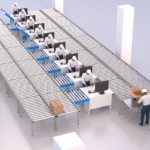- What challenges does a typical warehouse face that intelligent robots can address? Warehouses often struggle with slow order fulfillment, labor shortages, and high operational costs. Intelligent robots can automate repetitive tasks like picking, sorting, and storage, boosting efficiency and accuracy while reducing reliance on human labor.
- What types of intelligent robots are available for warehouse automation? A variety of intelligent robots exist, each with its own strengths. Fork AGVs and stacker cranes tackle heavy pallet movements, while tote stackers and four-way shuttles excel at handling smaller cargo. Unstackers/stackers and automated put walls streamline loading and unloading, while RGV carriers provide flexible transport options.
- How do intelligent robots integrate with existing warehouse management systems (WMS)? Advanced robots seamlessly connect with WMS platforms, ensuring real-time data exchange and synchronised operations. This allows efficient task assignment, optimised routing, and continuous inventory updates, promoting data-driven decision-making.
- What are the safety features of intelligent robots for warehouse environments? Safety is paramount. Intelligent robots utilise collision avoidance sensors, emergency stop mechanisms, and designated traffic lanes to prevent accidents. Additionally, their autonomous navigation minimises human interaction, further reducing potential risks.
- Can intelligent robots handle dynamic warehousing needs and changing order profiles? Absolutely! Modern robots are equipped with AI and machine learning capabilities, enabling them to adapt to new layouts, adjust routes based on changing order priorities, and learn from experience. This flexibility ensures smooth operation even in dynamic environments.
- How can we measure the return on investment (ROI) of implementing intelligent robots? Quantifying ROI involves analysing factors like increased storage capacity, faster order fulfillment, reduced labor costs, and improved accuracy. By calculating cost savings and productivity gains, you can demonstrably evaluate the financial benefits of robot integration
- What are the scalability options for intelligent robot fleets as the warehouse grows? Scalability is a key advantage. Modular robot systems allow you to add additional robots or upgrade capabilities as your business expands. This flexibility prevents over-investment while ensuring your automation solution grows alongside your operation.
- How can we ensure my team is comfortable and prepared to work alongside intelligent robots? Proper training and communication are crucial. Investing in employee training programs familiarises your team with robot capabilities and safety protocols, fostering collaboration and maximising the benefits of automation.
Empower your logistics with SmartlogitecX, fueled by WayZim Technologies. As leaders in Warehouse Automation for the Australian market, we’re dedicated to delivering efficiency and innovation right to your doorstep. SmartlogitecX’s approach is two-fold: globally informed, locally applied. Take the first step towards optimised operations by reaching out to our sales team for a solution that speaks directly to your needs



